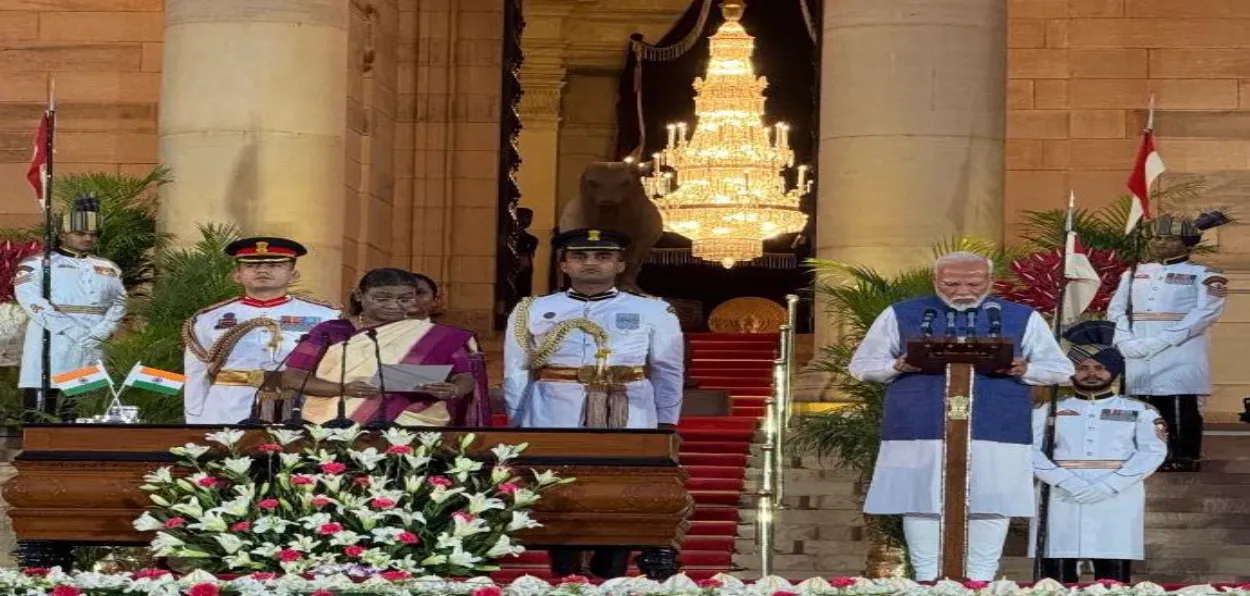
 Sushma Ramachandran
Sushma Ramachandran
The new National Democratic Alliance (NDA) government inherits a recovering economy but is equally faced with many challenges. These will be tackled by the newly minted Cabinet which has many familiar faces handling key economic portfolios including Nirmala Sitharaman, Nitin Gadkari, Piyush Goyal, and Ashwini Vaishnav. This brings a sense of continuity that is bound to provide reassurance to both domestic and foreign investors at a time when sustained economic growth is essential.
For the current fiscal - 2024-25 - GDP growth is expected to slow down to 6.5 to 7 percent following the 8.2 percent recorded last year. Even at this level, India is expected to remain the fastest-growing major economy in the world. But some areas of weakness need to be tackled immediately by the new government. The biggest one, highlighted through the months of campaigning, is unemployment. The results of any fresh policies may take a while to show results but action needs to be taken on this front without any delay.
One must first look at the data on this issue. The latest Periodic Labour Force Survey shows that the unemployment rate was 3.2 percent in 2022-23, only slightly lower than the 3.4 percent recorded in 2013-14. On the other hand, the private sector think tank, Centre for Monitoring Indian Economy (CMIE) puts the unemployment rate in April at 8.1 percent.
There may be variations in the jobs data but the fact is that unemployment is not a new problem. A major reason is the huge proportion of the working-age population that remains in the agriculture sector. As much as 45 percent of workers derive their income from agriculture, but this segment now comprises only about 15 percent of GDP.
The recent strategy of large-scale spending on infrastructure development has translated into job creation, but there are differing views on the extent of the increase. The government has been arguing that there has been a marked improvement, pointing to data from the Employees Provident Fund Organisation (EPFO), the Reserve Bank of India, and the National Career Services (NCS) portal to show that employment levels have risen over the past few years. Even so, the need for jobs is massive in a country with the world’s largest population.
Finance Minister Nirmala Sithraman
The first issue that must be accorded the highest priority in this regard is skilling or making education more relevant. Rashtriya Lok Dal chief Jayant Chaudhary has been given responsibility for this key ministry and will need to revitalise the entire system of skills development. This is imperative as un-employability has been a big problem in this country. Education needs to pivot to meet the needs of technological changes in the manufacturing and services sectors. It is essential to involve industry while formulating new educational strategies. Unless the huge youthful proportion of the population is given the skills needed to meet the changing requirements of industry, there will continue to be a mismatch between demand and supply in the jobs market.
The second area that needs more focus is attracting more foreign direct investment. The latest data from the Reserve Bank of India shows a decline in FDI inflows at a time when more capital is needed to expand the manufacturing sector. More greenfield projects are essential as these create ancillary industries as suppliers and this in turn enhances job opportunities.
Right now, it is evident that there is a window of opportunity to attract multinationals looking to implement a China Plus One policy - that is, finding alternative investment avenues to those in China. However these firms have several options. India faces competition from Vietnam and Indonesia where several international corporates have already set up shop. The former especially is being touted as having one of the easiest investment climates in Asia and is attracting many corporates looking for another option to China.
Linked to this is the need to improve the ease of doing business at the level of states and municipalities. The central government has already carried out a wide swathe of reforms in procedures and processes. But these need to be supported at the state level where regulatory frameworks often continue to be complex and bureaucratic.
The result is that setting up a new business still needs a plethora of clearances from various state or municipal-level authorities. One reason that southern states attract more foreign investment is the greater efficiency in systems and lesser red tape than elsewhere. So a review of procedural tangles is urgently needed right now otherwise this country will lose out to the savvier approach taken in other competing locations.
A third sector that needs more support is the small and medium business enterprises (SMEs) segment. These are largely labour-intensive enterprises and expansion in this sector means expansion of job opportunities. The SME sector faced extreme pain during the pandemic and has only seen a revival in the past two years. Several credit-linked schemes were launched at the time but much more support is needed for SMEs to remain vibrant and healthy.
And finally, it has to be said that the present government’s drive to develop infrastructure and long-term physical assets must be continued at least in the medium term. This will not only create valuable assets for the long run but will also give an impetus to job growth. Private investment also needs to be stepped up as it has still not picked up to the desired extent.
In the long run, concerted efforts must be made to shift workers away from the agriculture sector and into manufacturing or services. This process can only succeed if more jobs are available in these sectors. On the plus side, global research firm Nomura has said that India along with Vietnam will be the biggest beneficiary of the China Plus One strategy adopted by many multinationals. It has also predicted that annual GDP growth in this country will rise to ten percent over the period from 2024 to 2030.
ALSO READ: Indian economy in the pink of health for the next govt. to breathe easy
The research firm has observed that India is an attractive destination for consumer goods production to cater to both domestic market and export needs. In case this prediction is correct, there is likely to be a huge expansion of the manufacturing sector and a consequent increase in job creation. Given this optimistic outlook, there should be a focus on policies to make the investment climate easier for both domestic and foreign investors. These will give an impetus to a gradual shift of employment from agriculture to the industrial and services sectors. This is a task that needs to be on top of the new government’s economic agenda.
